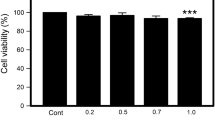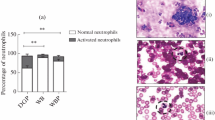Abstract
N-Formyl-methionyl-leucyl-phenylalanine (FMLP) stimulated a timeand concentration-dependent release of granule associatedβ-glucuronidase and lysozyme but not cytoplasmic lactate dehydrogenase from human neutrophils. Maximum discharge of lysosomal enzymes occurred two minutes after cell contact with FMLP. The percent of total enzyme activity released is insignificant when cells are not preincubated with cytochalasin B prior to being exposed to FMLP (10−10-10−7 M); although 11.2 ± 1.3 and 12.4 ±1.1% of total activity forβ-glucuronidase and lysozyme, respectively, is secreted from neutrophils with 10−4 M FMLP in the absence of cytochalasin B. FMLP-stimulated release of lysosomal enzymes occurs but is significantly curtailed in the absence of extracellular calcium. Incubation of neutrophils with EGTA in calcium-free medium, however, had no effect on FMLP-elicited lysosomal enzyme extrusion. 8-(N,N-diethylamino)-octyl-3,4,5-trimethoxybenzoate hydrochloride (TMB-8), a purported antagonist of intracellular calcium, demonstrated a dose-dependent inhibition of FMLP-induced release ofβ-glucuronidase and lysozyme from cytochalasin B-treated neutrophils in the absence of extracellular calcium. This effect of TMB-8 could be reversed with the addition of calcium to the extracellular medium. These studies indicate that TMB-8 may be useful in elucidating the role of calcium in the mechanism of lysosomal enzyme release.
Similar content being viewed by others
References
Cochrane, C. G. 1968. Immunologie tissue injury mediated by neutrophilic leukocytes.Adv. Immunol. 9:97.
Schiffmann, E., B. A. Corcoran, andS. M. Wahl. 1975. N-formylmethionyl peptides as chemoattractants for leukocytes.Proc. Nat. Acad. Sci. U.S.A. 72:1059.
Showell, H. J., R. J. Freer, S. H. Zigmond, E. Schiffmann, S. Aswanikumar, B. Corcohan, andE. L. Becker. 1976. The structure-activity relations of synthetic peptides as chemotactic factors and inducers of lysosomal enzyme secretion for neutrophils.J. Exp. Med. 143:1154.
Smith, R. J. 1978. Nonsteroid anti-inflammatory agents: Regulators of the phagocytic secretion of lysosomal enzymes from guinea-pig neutrophils.J. Pharmacol. Exp. Ther. 207:618.
Worthington Enzyme Manual. 1972. Worthington Biochemical Corp. Freehold, New Jersey. 100–101.
Sastry, B. V. R., andA. Lasslo. 1958. Aliphatic reserpine analogs.J. Org. Chem. 23:1577.
Malagodi, M. H., andC. Y. Chiou. 1974. Pharmacological evaluation of a new Ca++ antagonist, 8-(N, N-diethylamino)-octyl 3,4,5-trimethoxybenzoate hydrochloride (TMB-8): Studies in smooth muscles.Eur. J. Pharmacol. 27:25.
Day, A. R., R. J. Freer, H. J. Showell, andE. L. Becker. 1977. Demonstration of a receptor on rabbit neutrophils for chemotactic peptides.Biochem. Biophys. Res. Commun. 74:810.
Williams, L. T., R. Snyderman, M. C. Pike, andR. J. Lefkowitz. 1977. Specific receptor sites for chemotactic peptides on human polymorphonuclear leukocytes.Proc. Natl. Acad. Sci. U.S.A. 74:1204.
Henson, P. M. 1971. Interaction of cells with immune complexes: Adherence, release of constituents, and tissue injury.J. Exp. Med. 134(3,Pt. 2): 114s.
Hawkins, D. 1972. Neutrophilic leukocytes in immunologic reactions: Evidence for the selective release of lysosomal constituents.J. Immunol. 108:310.
Becker, E. L., H. J. Showell, P. M. Henson, andL. S. Hsu. 1974. The ability of chemotactic factors to induce lysosomal enzyme release, I. The characteristics of the release, the importance of surfaces and the relation of enzyme release to chemotactic responsiveness.J. Immunol. 112:2047.
Goldstein, I., S. Hoffstein, J. Gallin, andG. Weissmann. 1973. Mechanisms of lysosomal enzyme release from human leukocytes: Microtubule assembly and membrane fusion induced by a component of complement.Proc. Natl. Acad. Sci U.S.A. 70:2916.
Becker, E. L., andH. J. Showell. 1974. The ability of chemotactic factors to induce lysosomal enzyme release: II. The mechanism of release.J. Immunol. 112:2055.
Davis, A. T., R. Estensen, andP. G. Quie. 1971. Cytochalasin B: 3. Inhibition of human polymorphonuclear leukocyte phagocytosis.Proc. Soc. Exp. Biol. Med. 137:161.
Woodin, A. M., andA. A. Weineke. 1963. The accumulation of calcium by the polymorphonuclear leukocyte treated with staphylococcal leucocidin and its significance in the extrusion of protein.Biochem. J. 87:487.
Smith, R. J., andL. J. Ignarro. 1975. Bioregulation of lysosomal enzyme secretion from human neutrophils: Roles of guanosine 3':5'-monophosphate and calcium in stimulussecretion coupling.Proc. Natl. Acad. Sci. U.S.A. 72:108.
Smith, R. J. 1979. The guinea pig neutrophil calcium-dependent lysosomal enzyme secretory process: Inhibition by nonsteroid anti-inflammatory agents.Biochem. Pharmacol 28:2739.
Northover, B. J. 1977. Effect of indomethacin and related drugs on the calcium-dependent secretion of lysosomal and other enzymes by neutrophil polymorphonuclear leukocytes in vitro.Br. J. PharmacoL 59:253.
Henson, P. M. 1972. Pathologic mechanisms in neutrophil-mediated injury.Am. J. Pathol. 68:593.
Malagodi, M. H., andC. Y. Chiou. 1974. Pharmacological evaluation of a new Ca++ antagonist, 8-(N,N-diethylamino)-octyl 3,4,5-trimethoxybenzoate hydrochloride (TMB-8): Studies in skeletal muscles.Pharmacology 12:20.
Chiou, C. Y., andM. H. Malagodi. 1975. Studies on the mechanism of action of a new Ca++ antagonist, 8-(N,N-diethylamino)-octyl 3,4,5-trimethoxybenzoate hydrochloride in smooth and skeletal muscles.Br. J. Pharmacol. 53:279.
Charo, I. F., R. D. Feinman, andT. C. Detwiler. 1976. Inhibition of platelet secretion by an antagonist of intracellular calcium.Biochem. Biophys. Res. Commun. 72:1462.
Gorman, R. R., W. Wierenga, andO. V. Miller. 1979. Independence of the Cyclic AMP- lowering activity of Thromboxane A2 from the platelet release reaction.Biochim. Biophys. Acta 572:95.
Naccache, P. H., H. J. Showell, E. L. Becker, andR. I. Sha'afi. 1977. Changes in ionic movements across rabbit polymorphonuclear leukocyte membranes during lysosomal enzyme release: Possible ionic basis for lysosomal enzyme release.J. Cell Biol. 75:635.
Naccache. P. H., M. Volpi, H. J. Showell, E. L. Becker, andR. I. Sha'afi. 1979. Chemotactic factor induced release of membrane calcium in rabbit neutrophils.Science 203:461.
O'flaherty, J. T., H. J. Showell, E. L. Becker, andP. A. Ward. 1979. Neutrophil aggregation: Effect of the time and sequence of addition of calcium, magnesium and chemotactic factor.J. Reticuloendothel. Soc. 25:29.
Naccache, P. H., H. J. Showell, E. L. Becker, andR. I. Sha'afi. 1977. Transport of sodium, potassium and calcium across rabbit polymorphonuclear leukocyte membranes: Effect of chemotactic factor.J. Cell Biol. 73:428.
Becker, E. L., M. Sigman, andJ. M. Oliver. 1979. Superoxide production induced in rabbit polymorphonuclear leukocytes by synthetic chemotactic peptides and A23187.Am. J. Pathol. 95:81.
Avila, J. L., andJ. Convit. 1973. Studies of human polymorphonuclear leukocyte enzymes: I. Assay of acid hydrolases and other enzymes.Biochem. Biophys. Acts 293:397.
Bainton, D. F., J. L. Ullyot, andM. G. Farquhar. 1971. The development of neutrophilic polymorphonuclear leukocytes in human bone marrow.J. Exp. Med. 134:907.
Bentwood, B. J. 1979. Sequential degranulation of human neutrophils.Fed. Proc. 38(Part 2):1362.
Estensen, R. D., J. G. White, andB. Holmes. 1974. Specific degranulation of human polymorphonuclear leukocytes.Nature (London) 248:347.
Bainton, D. F. 1973. Sequential degranulation of the two types of polymorphonuclear leukocyte granules during phagocytosis of microorganisms.J. Cell Biol. 58:249.
Nachman, R., J. G. Hirsch, andM. Baggiolini. 1972. Studies on isolated membranes of azurophil and specific granules from rabbit polymorphonuclear leukocytes.J. Cell Biol. 54:133.
Avila, J. L., andJ. Convit. 1973. Studies on human polymorphonuclear leukocyte enzymes: II. Comparative study of the physical properties of primary and specific granules.Biochim. Biophys. Acta 293:409.
Author information
Authors and Affiliations
Rights and permissions
About this article
Cite this article
Smith, R.J., Wierenga, W. & Iden, S.S. Characteristics ofN-formyl-methionyl-leucyl-phenylalanine as an inducer of lysosomal enzyme release from human neutrophils. Inflammation 4, 73–88 (1980). https://doi.org/10.1007/BF00914105
Issue Date:
DOI: https://doi.org/10.1007/BF00914105




